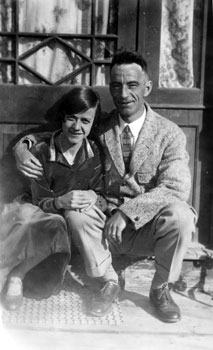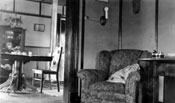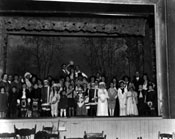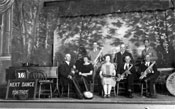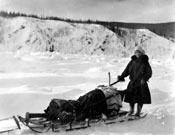        |  |
                 | |
|
Desperate in Dawson
|
||||||||||||
 |
|||||||||||||
 |
|||||||||||||
|
A home of their own
On August 23, after the couple had been settled in their new home in Dawson City for just over a week, Claude wrote to Mary’s sister:
Well, well! We’re home Anna! Home!! It’s such a wonderful word isn’t it? Its been many years since I’ve experienced the joys of home, and to me, having spent so much time during the past fifteen years in cabins, tents and other such places – why, I can tell you that our home here looks like heaven to me. (91-112 f. 2, MSS 365 Aug. 23, 1925)
Together the couple explored the wilderness around Dawson. Mary, he told Anna, "is perfectly happy." This would soon change.
As Dawson declined, desperate attempts were made to maintain the social whirl of Dawson’s glory days. This demanded compromises. For instance, as Mrs. Berton revealed, constables and NCOs had previously not been deemed sufficiently high class to enter some homes socially, or to attend fancy balls. With a shortage of men, it was finally assumed that any policemen at the balls were better than none. It’s likely that Mary, wife of an NCO, would have been aware of lingering prejudice. At any rate she laboured hard to present a good home and to meet social demands, including playing in the ladies’ curling league and participating in the local theatre.
Claude, who had created a niche and name for himself in Dawson society well before Mary came along, was more comfortable in the community and during his stationing there contributed his skills as a musician to the night life and to the church. He also liked to partake in local sports, and was an excellent skater. His photography brought him recognition as well, and he kept up a steady side business providing pictures to his Dawson clientele.
The happiest moments Mary knew during this period were, not surprisingly, outside of Dawson, on the trail with her husband and dogs, or in a little cabin, a weekend getaway they sometimes traveled to by dog sled.
Eventually the social pressures became too much for Mary, and she returned to Fort Yukon in the spring of 1926 to undergo treatment with Dr. Burke, presumably for depression. While she was recovering there, she expressed regret and self-doubt. She questioned her decision to marry Claude and her worthiness as a wife. It was likely one of the darkest times of Mary’s life. Her illness prompted Claude to ask for a transfer to a more remote post far from the social rigours of Dawson. In March, they learned that his request had been granted.
Mary later recalled the afternoon when Claude ran home with news of the transfer:
Sweetheart, we are to be sent to the Ross River Outpost – the O.C. signed the transfer this morning. We are to go with ‘The Thistle’ on her Pelly River trip when navigation opens in June. (Life in the Yukon, p.13)
Her life turned around in an instant:
I was wild with excitement, too. Ross River! It was our dream, our chance for an adventurous life of our own, free from the artificial demands of the too highly organized social life in the semi-‘ghost town’ of Dawson. (Life in the Yukon, p.13)
|
|||||||||||||
| Slideshow |  |
